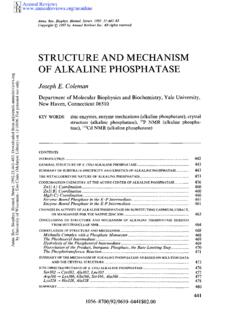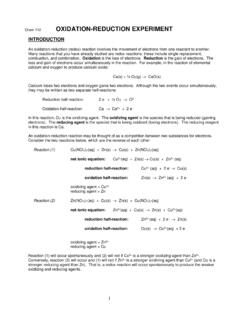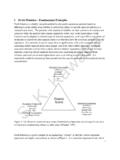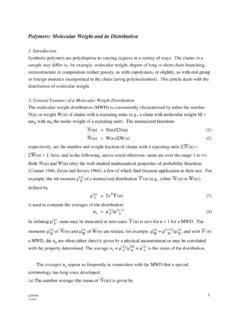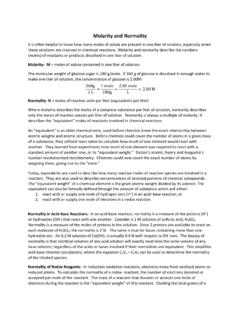Transcription of Chem 101: General Chemistry Lecture 1 - Matter ...
1 1 Chem 101: General ChemistryLecture 1 - Matter , Measurements, and CalculationsI. IntroductionA. Matter is the substance of everythingB. Chemistry is the study of matter1. Understanding Chemistry is necessary for individuals who are studying awide variety of areasa. Health Sciencesb. Biologyc. Geologyd. Astronomye. Law enforcementC. This chapter1. Presents some fundamental ideas about matter2. Quantitative measurements3. Scientific measurement systemII. What is Matter ?A. Definitions1. What is Chemistry ?a. The study of matter2. What is Matter ?a. Occupies volume and has mass3. What is mass?a. Is the measure of the amount of somethingb. In physics it is related to forces and inertia (resistances to forces)i.
2 Would you rather kick a balloon or a bowling ball?ii. The gravitational pull on an object is proportional to What is It is the amount of gravitational pull on an A rock weighing 16 pounds on earth would way poundson the moon. (1/6).ii. The rock has the same mass on both the earth and We will often use the term weight when we mean massc. Scales are used to measure weight, whereas balances are used tomeasure : Prove that air is Properties and ChangesA. Properties are those things that allow you to distinguish one object from another1. Compare the rock, the water and the air-filled There are two basic categories of properties1. Physical PropertiesChem101 Lecture 1 - Matter , Measurements, and Calculations2a.
3 Those observed or measured without changing or trying to changethe composition of the Chemical Propertiesa. Burn the candleC. Physical versus Chemical change1. Physical change is where the physical properties of a substance changeswithout a change in its chemical For examplei. Ice meltingii. Water evaporatingIV. A Model of MatterA. Scientific Models1. Are created to help us visualize the natural world around Models are developed to explain observed The can be used to predict new Observed behaviors of gases include:1. Volume at constant temperature decreases with increasing Volume maintained at constant pressure increases with Gases have Gases mix readily with one From these observations a simple model of Matter was created which works notonly with gases, but also with liquids and solids:1.
4 Matter is made up of tiny particles called Molecules are the smallest division of Matter that displays the chemicaland physical properties of a pure Any further subdivision requires a chemical changes, whichchanges the composition and hence the chemical and physicalproperties of the Molecules are made of Atoms are the smallest division of an Different atoms are combined in different proportions to make differentmoleculesa. Each type of molecule contains a fixed composition of atoms in afixed For example:1. All water molecules (H2O) contain 2 hydrogenatoms plus 1 oxygen All carbon dioxide molecules (CO2) contain 1carbon atom plus 2 oxygen All oxygen molecules (O2) contain 2 oxygen Classification of MatterA.
5 All Matter is either a pure substance or a mixture of pure Pure substances have a fixed composition and a defined set of chemicaland physical propertiesa. Example, water is a pure substanceChem101 Lecture 1 - Matter , Measurements, and Calculations3i. It freezes at 0 Cii. It boils as 100 Ciii. Its composition is always two parts hydrogen to two Example, table sugar (sucrose) is a pure substancesi. It also has a defined set of physical properties and itscomposition is 12 parts carbon, to 22 parts hydrogen to 11parts The physical and chemical properties of a pures substance can bequite different than the chemical and physical properties of theelements that make up its moleculesi. For example1.
6 Water is a clear, colorless liquid that is Hydrogen is a clear, colorless gas that is Oxygen is a clear, colorless gas that is notflammable but reacts readily with many Mixtures are mixtures of pure substancesa. Example, sugar water is a mixturei. Its composition varies depending on how much sugar isdissolved in the Its physical properties varies with composition,1. When making candy, the boiling point of sugarwater increases as the water is boiled Correspondingly, its physical propertieschange. Soft ball , Hard ball , The pure substances in a mixture can be separated by For example, salt water is a mixture1. The components of this mixture can be separated byboiling off the water, leaving the salt behindc.
7 The physical and chemical properties of a mixture resemble amixing of the physical and chemical properties of the puresubstances of which it is Mixtures can be heterogenous or Homogeneous mixtures are mixed at the molecular The look the same every For example: sugar The word solution is often used to refer tohomogeneous Heterogeneous mixtures are For example, a mixture of sugar and Close examination reveals the individualgrains of sugar and , and : Elements, pure substances, compounds, mixtures, Elementsa. Pure substances composed of homoatomic molecules are There are a little over 100 elements, which are displayed on theperiodic table of the 1 - Matter , Measurements, and Calculations4c.
8 The smallest division of some elements is an atom instead For example, the elements in the last column of the periodictable, which are called Noble or inert Compoundsa. Pure substances composed of heteroatomic molecules are There a millions of different kinds of Elements cannot be chemically divided into simpler puresubstances, but compounds For example, the electrolysis (a chemical change) of water(a compound) produces hydrogen (an element) and oxygen(an element).1. Neither hydrogen, nor oxygen, can be reduced Measurement UnitsA. Units give numbers meaning1. When doing measurements in the lab it is important to always include When working problems it is also important to include the unitsa.
9 Analyzing the units can help you determine if you have worked theproblem For the most part we will be using the SI (Syst me International d Unit s)1. This is based on the metric system2. The basic units in the SI system area. Mass - kilogramsb. Length - metersc. Time - secondsVII. The Metric SystemA. The metric system is a decimal systemB. Most units are derived1. Area - meters x meters (m2)2. Volume - meters x meters x meters (m3)3. Energy - kilograms x meter x meter / (second x second) (kg m2/s2)4. Some derived units have their own namea. 1 Joule = 1 kg m2/s2C. Prefixes are used to scale the unitsTable - Common prefixes of the metric systemD. Commonly used metric units and conversionsTable - Commonly used metirc unitsExercises 1 - Matter , Measurements, and Calculations5 VIII.
10 Large and Small NumbersA. Can use metric prefixes to move decimal place aroundB. Also use scientific notation1. Review entering scientific notation in calculator2. Adding exponents in multiplication3. Subtracting exponents in divisionIX. Significant FiguresA. Report all digits you a confident in plus the first digit that you are uncertain Addition and subtractionC. Multiplication and DivisionD. Exact numbers1. 1m = 100 cmX. Using Units in CalculationsA. Write down what you know and what you want to find outB. Include units in calculationsC. Do calculations with the units first to see if you answer will have the correct Plug numbers into calculatorXI. Percent CalculationsA. Part/Whole X 100%XII.




